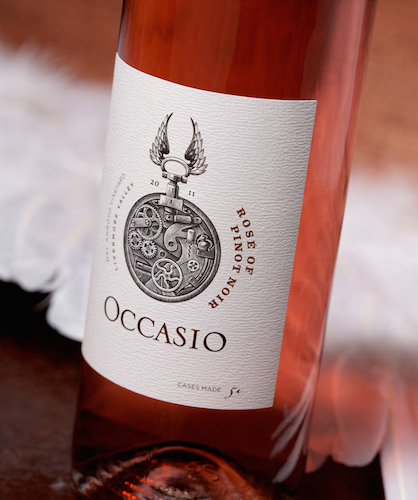Harvesting Spring, in the Fall – The Making of Occasio Rosé

Soon we will be harvesting Pinot Noir for what will become our sixth vintage of Rosé. This early season wine is highly praised (the Santa Rosa Press Democrat selected Occasio as a Top Five producer of California Rosé), with our Rosé of Pinot Noir having been called “a glass of spring.” So popular is this “season in a bottle” we sell out annually when we release in May. Yet, as satisfying as public reception and expert reviews are, each and every year we debate at length how we can make an even better wine.
There are two ways to make Rosé: saignée, where juice is drawn off from a red wine prior to fermentation, and the direct method, where fruit is harvested for the single purpose of making Rosé wine. The saignée method is usually an afterthought, as the winemaker’s purpose is to produce a red wine, but needs to draw off some of the juice either to correct an overripe must or for quick revenue while the red wine matures. Because the fruit is harvested late, saignée Rosé almost always lacks the vibrancy that characterizes the best wines.
Occasio Rosé of Pinot Noir is crafted from fruit harvested only for Rosé and thusly, we harvest a month or more before the rest of the Valley. The fruit is hand harvested, stemmed, and literally crushed by hand as we wait for the color and flavors of the skins to release into the juice, a process that can take many hours. The juice is then cold settled, and when it is of optimal clarity we gradually warm and allow fermentation to begin.
We always reserve a case of the finished wine for study and comparison. Throughout the year, I sit down with our winemaker and viticulturist and compare our past vintages with the finest examples of Rosé from Europe, Oregon, and California. We discuss what makes the great wines great, and determine how we can make our wine better. We are brutally honest – only the grapes are allowed thin skins.
Last week we completed our final Rosé tasting. The farming decisions are behind us and now our attention focuses on harvest. The frequency of vineyard sampling has increased, and we are going through the final preparations, readying to receive the grapes. Now, I await my most important decision – taking what I have learned and using it to choose the perfect moment to harvest.


